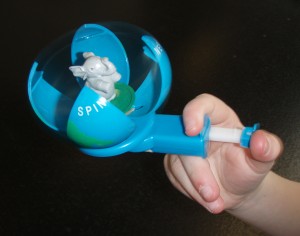When I walk into a classroom, many of the students lift their heads expectantly and frequently plead, “Take me!” I carry a bag of toys. Each toy, ofcourse has a purpose, and some are actually quite difficult. But the kids always step up to the challenge. A favorite of theirs (which always brings a crowd) is the spinner. It is a great workout for the fingers, especially for the all important thumb!
Benefits:
- Visual focus: holding the toy correctly requires guidance from the eyes and visual attention.
- Increase hand and finger strength(especially the thumb): pumping requires sustained muscle action from the thumb and a static holding position from the index and third fingers.
- Improving hand dexterity: The pumping requires the isolation of movement in the fingers.
- I use the spinner, ironically, as a reward and a rest period from other work, such as writing.
- It can be used as preparation for a writing assignment by “waking up the hand or “writing muscles.”
- Pumping the spinner can reinforce counting lessons by having the child count along.
Directions:
1. As the child holds the spinner exactly the correct way (refer to photo) the lever pumps in and out until the globe opens and a surprise animal is seen inside. Place the spinner in the child’s dominant hand, positioning the fingers correctly. The thumb is always on the lever.
2. The trick is to keep an even pumping motion going so the globe stays open.
3. Once the child masters the mechanics I encourge them to try to pump 50 times.
Special Considerations:
- Some children need help to initially stabilize the spinner with the other hand.
- Once they are strong enough and have the motor plan I encourage the student to hold it only with the one hand. This is more difficult but a better challenge for the fingers.
- When first getting started you may need to help push the child’s thumb in one or two times to get the momentum going.
- BEWARE: If the child’s thumb “caves in” or hyperextends, meaning the thumb bows outward rather than bending at the knuckle towards the palm, the thumb is not strong enough for this activity. Either help support the thumb joint or go back to plant sprayers and other hand strengthening activities.
Targeted age range:
Preschool: The same method described above can be employed. Using two hands to stabilize might be helpful. You may need to assist getting the spinner going for a longer period.
Kindergarten: Expect the child to count independently up to 10 or 20.
Elementary: The child should be able to hold the spinner independently and continue pushing for more than a minute.
Post College Graduates: Seem to enjoy this toy ….
Resources:
I have found push spinners at check out counters and especially at museum and zoo gift stores.
I could not find the spinner pictured above on line but the site below has others. Sparklers were the original push spinner and I am very sad that it is hard to find them now. They make for a great physics lesson about friction.
http://us.ebid.net/for-sale/tin-toy-sparking-push-spinner-31812265.htm?from=googlebase
